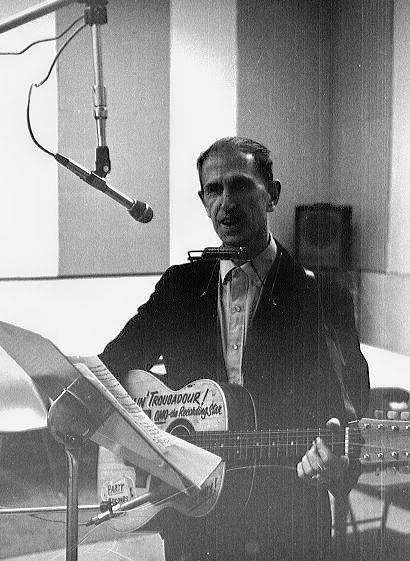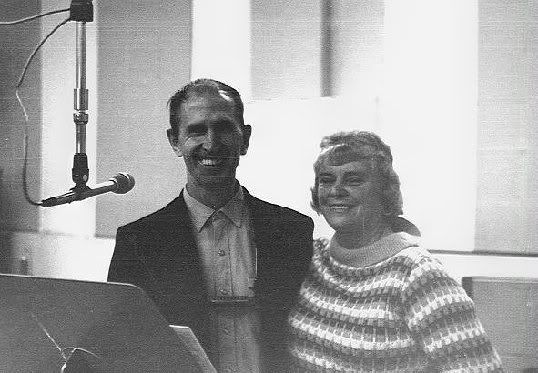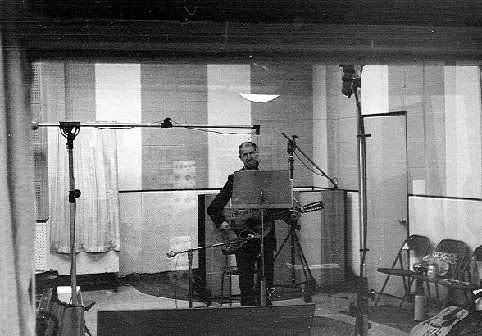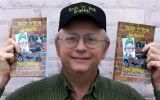
Well-known as Omo the Hobo, this Delta County native played
under the name Smiley Joe Omohundro when this picture was taken in 1960.
By STEVE SEYMOUR
Delta County's Omo the Hobo issued so many 45 rpm singles during his career that a complete listing is probably not possible.
Even a partial discography of his seven-inch records contains a remarkable 150 entries.
Most singles appeared on his own label, while dozens were issued by Accent Records, based in Hollywood, California.
Consider that each single contained two songs and you begin to see how prolific Omo was as both a composer and recording artist.
Some of Omo's most popular songs were released more than once, often with different flipsides, making an accurate accounting difficult.
You should know Omo was born Wellman W. Omohundro at 8:12 p. m. on Oct. 3, 1917 on the family farm near the historic community of Fayette on the Garden Peninsula.
As Omo was quoted in a brief biography printed on one of his picture sleeves, "he was one of three children that lived."
Not liking the hard labor involved in farm life, he left home at age 18, in the middle of the Great Depression.
He tried all kinds of jobs and discovered he "was no good at any of them."
Consequently, he enlisted as a private in the U. S. Army on April 4, 1941 eight months before the Japanese attacked Pearl Harbor.
After the war, Omo became a "strolling troubadour and made his living singing and playing in bars throughout the country."
The sleeve notes claimed Omo "started with nothin' and still got nothin'."
Still, Omo made a living for himself because he had learned to "play the guitar and harmonica and sing a little."
Omo said he wrote songs "for the president on down to the bum" as well as a few about himself.
He recorded as Smiley Joe Omohundro until the mid-1960s, later as Omo the Hobo and occasionally Omo the Lobo.
Looking to appeal to every audience, the Upper Peninsula native wrote and recorded songs which were purposefully sentimental, humorous, ribald or even religious in content.
As Omo was launching his career, he placed a classified ad in the Oct. 30, 1954 issue of Billboard magazine. The advertisement read: "Girl partner wanted- single, white, 25-33, singer to team up and build western act." 
Catching a bit of a break, Omo met Scott Seely, artists and repertoire chief for Accent Records. A songwriter and producer, Seely signed Omo to his fledgling label, founded in 1954.
Documentation of the 45s released by Accent is incomplete, but the first record Omo issued may have been "I Don't Drink to Get Drunk"' backed with "Brother, I've Had It."
The top side was attributed to Baby Doll Omohundro, apparently the young lady who responded to his Billboard ad, while the flip was credited to Smiley Joe.
The 45 was assigned catalog number 1076. The same tracks were released as Accent 1080, with each artist performing the other song.
Two more Omo 45s followed in the sequence. Accent 1081 featured "Shut That Gate" and "Do You Cheat on Your Wife?" while the next record comprised "Someone's Just Waiting To Take What I Got" and "They Made a Fool Out of Me." Smiley Joe was credited with all the songs except "Wife" which was performed by Baby Doll.
Accent's most successful act was Buddy Merrill, featured guitarist for the Lawrence Welk Orchestra, who released over two dozen albums for the label.
Omo was quite productive himself. One estimate is that he released a total of 45 seven-inch singles for Accent, located on prestigious Hollywood Boulevard.
When his tenure with Accent ended in 1965, Omo decided to carry on by releasing records on his own Omo the Hobo label.
Issued as catalog number 101 was a pairing of "Keep Smiling" and "Omohundro or Mohundro," a track which dealt with the two versions of Omo's last name.
"Keep Smiling" began another run of records, numbering more than 100, which Omo issued primarily in the 1960s and 70s.
A savvy marketer, Omo included a list of his recordings on picture sleeves distributed with his 45s informing potential customers of his extensive catalog.
I recently acquired one of those sleeves which helped in assembling a discography as well as providing additional insight into his life's work.
Omo had at least some of his 45s pressed at Monarch Records in Los Angeles. Matrix numbers preceded by a small triangle reveal that a single called "Alky-holic Is My Name" was pressed there in Feb. 1966. The record was actually a reissue of his last known Accent sides from the previous year.
Besides singles, Omo recorded enough material to issue a dozen extended play discs (EPs), each containing four to six songs. In his listing, Omo noted another EP with eight songs was lost at Alco Records.
In addition, Omo's catalog was bolstered by a number of full-length long-play albums.
One series started with "Party Record No. 1" and continued for eight volumes. There was also a series of family records.
Omo sold his singles for $2 and albums for $5. He also offered tapes for $7 and calendars or "health books" for $2 each.
Often on the road, Omo received mail at Post Office Box 2002 in South Gate, California.
He supplemented his income from record sales by playing for donations in bars and nightspots around the country, never staying in one spot too long.
He often played an acoustic guitar with "Omo the Hobo" painted at the top and the request "No drinks, tips only," painted below.
Another six-string used early in his career displayed the words "Strolling Troubadour" and "Smiley."
Omo encouraged patrons to buy a record as a souvenir and asked them to request one of his songs on their favorite radio station.
After decades on the move, Omo returned to the Upper Peninsula, living in Escanaba during his later years.
The aging musician kept his massive inventory of records in his basement, his friend Bud Irving told me.
Omo's career fell silent in 1996 when he died at the D. J. Jacobetti Home for Veterans in Marquette.
Irving now owns one of his guitars, while his myriad records have homes far and wide, which seems perfectly appropriate for a traveling musician called Omo the Hobo.
#
Photo album from Fidelity Recording Studios, 1969, courtesy of Randy Hauck. 



CLICK HERE
FOR THE OMO THE HOBO DISCOGRAPHY
As compiled by Steve Seymour


 I've enjoyed rock music and writing since I was a teenager in the 60s. I feel lucky to have been around when rock's greatest stars created their most enduring hits. At the same time I found I enjoyed writing, as well. I worked on my high school newspaper and magazine, was editor of several college publications and earned a bachelor's degree from Central Michigan University in 1973. I worked for the daily newspaper in my hometown after graduating, becoming managing editor after a few years. By the 1980s, I moved into public relations. In 1985, my wife Sue and I opened a retail music store, The Record Rack, which we still own. Rock 'n' roll has been integral to me and for the last 2O years I've been earning my living from it even though I don't have a musical bone in my body. In recent years, I've also I edited a small local magazine and launched a micro FM radio station. Now, I'm finally combining my love of writing and rock 'n' roll. I can't sing a note, but I know what I like. I'll tell you all about it when you read on. I hope you have as much enjoyment reading these installments as I've had writing them.
I've enjoyed rock music and writing since I was a teenager in the 60s. I feel lucky to have been around when rock's greatest stars created their most enduring hits. At the same time I found I enjoyed writing, as well. I worked on my high school newspaper and magazine, was editor of several college publications and earned a bachelor's degree from Central Michigan University in 1973. I worked for the daily newspaper in my hometown after graduating, becoming managing editor after a few years. By the 1980s, I moved into public relations. In 1985, my wife Sue and I opened a retail music store, The Record Rack, which we still own. Rock 'n' roll has been integral to me and for the last 2O years I've been earning my living from it even though I don't have a musical bone in my body. In recent years, I've also I edited a small local magazine and launched a micro FM radio station. Now, I'm finally combining my love of writing and rock 'n' roll. I can't sing a note, but I know what I like. I'll tell you all about it when you read on. I hope you have as much enjoyment reading these installments as I've had writing them.


2 comments:
I remember Omo Joe, who used to hook up with the traveling rodeo in summer months on the East Coast. I saw him in the late-60's at Roundtop mountain rodeo in the Catskills. Me and my buds were dude ranch hands at the Baliwick, which was near the Catskill Game Farm. He certainly was something else for us teenagers to see, and we envied his freedom to keep n the move. He told us that in the winter months, he would work his way south to follow the warm weather. Thanks for remembering him.
--Lee from Staten Island, NY
Omo appeared at Shapanack, also located in Catskill Mtns. I still have his 45 record w/ cover and autograph ! Great memories ! RIP Omo @}---->
Post a Comment